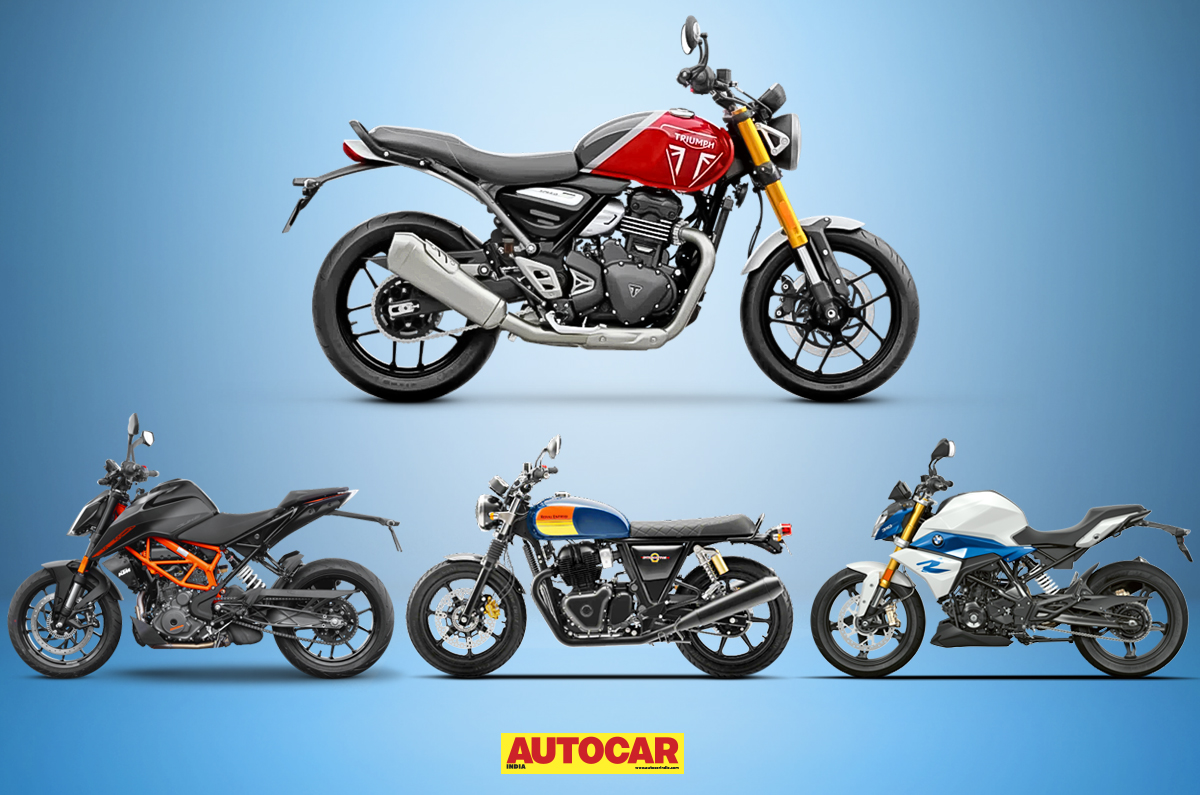Triumph Speed 400 vs rivals: price specifications compared

The brand new Triumph Speed 400 enters a hotly contested segment and we stack it up against its primary rivals on paper.
Triumph Speed 400 vs rivals: engine & output
| Engine & output | ||||
|---|---|---|---|---|
| Triumph Speed 400 | KTM 390 Duke | RE INT 650 | BMW G 310 R | |
| Engine | Liquid-cooled, 398cc, single-cyl | Liquid-cooled, 373cc, single-cyl | Air/oil-cooled, 648cc, parallel-twin | Liquid-cooled, 312cc, single-cyl |
| Power | 40hp at 8,000rpm | 43.5hp at 9,000rpm | 47hp at 7,250rpm | 34hp at 9,250rpm |
| Torque | 37.5Nm at 6,500rpm | 37Nm at 7,000rpm | 52.3Nm at 5,150rpm | 28Nm at 7,500rpm |
| Gearbox | 6-speed | 6-speed | 6-speed | 6-speed |
| Power-to-weight ratio | 235hp/tonne | 254hp/tonne | 215hp/tonne | 207hp/tonne |
The Speed 400’s brand new engine isn’t the most powerful in this company, but it makes more torque than any other single-cylinder competitor. And with the Speed being a roadster rather than a sporty naked, this engine’s mid-range performance should be quite enjoyable. Unsurprisingly, the largest and smallest bikes here are the most and least powerful, respectively.
Triumph Speed 400 vs rivals: weight & dimensions
| Weight & dimensions | ||||
|---|---|---|---|---|
| Triumph Speed 400 | KTM 390 Duke | RE INT 650 | BMW G 310 R | |
| Kerb weight | 170kg | 171kg | 218kg | 164kg |
| Seat height | 790mm | 822mm | 804mm | 785mm |
| Wheelbase | 1377mm | 1357mm | 1398mm | 1380mm |
| Fuel capacity | 13 litres | 13.4 litres | 13.7 litres | 11 litres |
| Ground clearance | NA | 151mm | 174mm | NA |
Weighing 170kg and with a seat that’s just 790mm off the ground, the Speed 400 should be one of the more manageable bikes in this space. However, the diminutive G 310 R takes that one step further with an even lighter kerb weight and shorter perch. While the 390 Duke’s saddle is the tallest, it's quite narrow where the tank meets the seat, which should help shorter riders.
Triumph Speed 400 vs rivals: suspension & brakes
| Suspension & brakes | ||||
|---|---|---|---|---|
| Triumph Speed 400 | KTM 390 Duke | RE INT 650 | BMW G 310 R | |
| Suspension (f) | 43mm USD fork | 43mm USD fork | Telescopic fork | 41mm USD fork |
| Suspension (r) | Monoshock | Monoshock | Twin shock absorbers | Monoshock |
| Brakes (f) | 300mm disc | 320mm disc | 320mm disc | 300mm disc |
| Brakes (r) | 230mm disc | 230mm disc | 240mm disc | 240mm disc |
| Tyres (f) | 110/70-R17 | 110/70-R17 | 100/90-18 | 110/70-R17 |
| Tyres (r) | 150/60-R17 | 150/60-R17 | 130/70-R18 | 150/60-R17 |
The Speed 400’s suspension and braking hardware is par for the course in this segment. However, it remains to be seen whether the premium Metzeler or Pirelli rubber it is seen rolling on in the press shots overseas makes it to our shores. Except for the Interceptor 650, which rolls on 18-inch rims and features more basic suspension hardware, all the bikes here roll on conventionally sized 17-inch units and have a USD fork/monoshock set-up.
Triumph Speed 400 vs rivals: features
Currently, the Triumph Speed 400 is the only bike here to come with a switchable traction control system, an immobiliser and heated grips, albeit the latter is an optional extra. It also gets full-LED lighting, ride-by-wire throttle and a USB type-C charger. The 390 Duke is the only bike here to feature a colour TFT dash with Bluetooth connectivity. Despite the fact that the Interceptor 650’s digi-analogue dials pack in fairly little data, they remain pleasing to look at in an era of increasingly digital displays.
There is also the fact that the new small-capacity Triumph duos appear to be very well-finished with neat welds, high-quality fasteners and great attention to detail, which should further boost their curb appeal. We will soon get a chance to hop aboard the new Speed 400, so make sure to watch this space for our reviews.
Also See:
Triumph Speed 400, Scrambler 400 X first look video
Would you choose the Triumph Speed 400 over its competitors? Let us know in the comments section below.
from Autocar India https://ift.tt/Q5v0eNr
Comments
Post a Comment